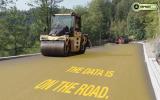
The world is changing, mobility is changing and so roads must change and adapt for the future.” With this brief statement, Jacques Tavernier opened the second PPRS Summit.
“At the same time there is a growing awareness of poor or non-existent maintenance for highways. The question for this conference is how to adapt road maintenance in the face of this challenge,” said Tavernier, in his role as president of the PPRS Congress Nice 2018 that was held over three days in the Nice Acropolis.
The need for a strategic long-term approach to road maintenance has been recognised in France with the recently set up National Observatory for Roads, explained Frederic Beauchef, vice president of France’s Sarthe County Council.
The observatory was created with the central government at the insistence of France’s local government authorities - the Departments which have seen their revenues from Paris decline over the past decade, explained Beauchef.
The has led to “painful choices” in order to fulfil the duty of the local government preserve the precious public asset, he told the opening session. The observatory is monitoring the condition of France’s departmental roads using a template as part of a strategy to prioritise maintenance.
There remain sensitive road-user issues in France, said Beauchef. One is the increasing number of heavy trucks which cause the most road damage but are not being taxed accordingly.
Lessons learned
You learn from successes but also from failures, despite the pain, said Anne-Marie Leclerq, deputy minister for infrastructure within the ministry of transport for the Canadian province of Quebec. On September 30, 2006, a span of the six-lane Concorde Bridge in Laval, near Montreal, collapsed, crushing to death five people and injuring six.
The bridge had been inspected only recently, she told attendees. Inspection teams did see some concrete rubble at one corner of the road under the bridge, but it was too late. Soon after a 20m section had a catastrophic failure that would change forever the way the Canadian province inspected bridges.
Although putting in mostly only one layer of steel reinforcement was not a contravention of building codes at the time, it was found to create a weak plane. There were also issues over the quality of concrete used for abutments. The finger of blame was pointed at several engineering firms over the years for inadequate repairs and inspections.
But the result was an impressive tightening up of building codes and in particular inspection regimes, she explained. This is important because 70% of the province’s bridges date from the era as that of the Concorde Bridge, between 1960 and 1980.
There are now specialist inspection teams available to local authorities on a 24/7, 7/7 basis. A closer review of on-site new construction work is in place. While the province has not introduced a BIM process, it is at least considering its use, said Leclerq.
“Enriching the maintenance environment” is one of the most important lessons to be learned from disasters, said Yukio Adachi, a director of management planning for the Japanese firm Hanshin Expressway Engineering.
“A disaster is a crisis that exceeds the capabilities” of infrastructure to maintain integrity. That is the definition of failure as used for a major study of 15 bridge failures by
Asset management should be reviewed to accommodate the fact that designs have greatly moved on from the 1960s and 1970s. What were sufficient inspection regimes for new designs back then should be updated and intensified for the fact that materials have aged. Traffic weight limits and numbers have been reached or exceeded, at times placing excessive stress levels on the design. If there have been periods of infrequent or no maintenance, then succeeding levels should be intense and much more frequent.
If there were known errors during the construction phase, and even if these were corrected, Adachi suggested that much more non-destructive testing be carried out to ensure a structure's continuing integrity. This should happen even if the structure has been well-maintained and documented as such.
However, failure can be caused by outside influences that have nothing to do with the integrity level of the structure itself. This was the case of a fire under an overpass of the 10-lane Interstate 85 near Atlanta, in the US state of Georgia only a year ago.
A large amount of plastic conduit was stored under a span of the I-85 to keep it dry. But a suspected arsonist created a fire of such intensity that the heat and smoke engulfed the five-lane 30m span and collapsed it – only 45 minutes after the fire had been detected.
Luckily, no one was killed or injured during the rush hour disaster of the 30-year-old structure that carries 250,000 vehicles a day. However, the state government alerted local authorities to not store material under an overpass, said Meg Pirkle, chief engineer with the Georgia Department of Transportation.
There could have been a disaster of a traffic jam kind had the GDoT not pulled together all the engineering, emergency services and communications teams, even as the fire was being extinguished, she told delegates. An hour after the fire had been detected, an emergency operations centre was set up. Four hours after the fire was detected, demolition contractors were on-site waiting for the debris to cool down.
Rather than source steel replacement beams of a 30-year-old design, the bridge’s original designers – who were rebuilding the span – updated the design with stronger bulb tee beams. Being longer, these beams could be installed more quickly than the original style beams and with a single crane movement per beam, said Pirkle.
The contractor also replaced several adjoining spans because of heat damage, which complicated the work because of their individual trapezoidal shape. However, the contractor was incentivised with $3.1 million to complete the estimated two-and-a-half-month operation a month early; it opened only six weeks after the fire.
During the whole process, Pirkle said the bridge authority was under intense media and public pressure to complete the work. Communication with the public was tremendously important to keep them on side.
In fact, by communicating possible travel delays, there were very few traffic jams as people flocked to public transport. There was generally 40% less traffic in affected areas and a minimal increased use of other arteries. Public transport authorities also noted a 27% rise in ridership during the construction period.
Yvonne Gunreben, of the federal German ministry of transport, told delegates that disaster was avoided in the case of the Leverkusen Bridge. The cable-stayed suspension design has one set of towers and cables in the middle of the road to support a steel girder road deck. The 1965 structure over the Rhine River connects the cities of Cologne and Leverkusen.
The bridge is also known as the A1 Rheinbrücke because it is a main route to the Dutch industrial port of Rotterdam. As such, it is used by heavy trucks that have got heavier over the decades. Around 120,000 vehicles use the bridge daily, of which around 12% are heavy trucks.
It was all a wake-up call that forced the hand of the Federal German Government to allocate a higher-than-expected amount of the road budget to maintaining bridges. Around 35% from now until 2020 is going towards bridges, increasing after that to 43% up to 2030.
Data is key
“Information and data is expensive to collect,” said Bud Wright, chief executive officer of AASHTO - American Association of State Highway and Transportation Officials. “As well, each state has different resources to do this.
“There are also political concerns and priorities. This can manifest itself in a state government versus local authority conflict when setting targets for maintenance. All the while, never forget that the vision remains a collective one, that being better asset management at all levels.”
Delegates also heard how one European project, Isabela, is attempting to quantify the social implications of highway asset management.
The research is attempting to produce an analytical tool that can be used within most asset management systems to input hard on the effects of maintenance decisions, explained Alfred Weninger-Vycudil, with Austrian-based PMS-Consult.
The research is looking at the “social implications” of maintenance, including the monetary value of having a road out of commission at different times of the year and also for differing lengths of time. What is the effect on the local and regional economy? How are people’s movements affected and what it the result on lost business versus improved business if roads are improved?
Most decisions to maintain roads are made by technical people but funding is often based on social issues, he said.







